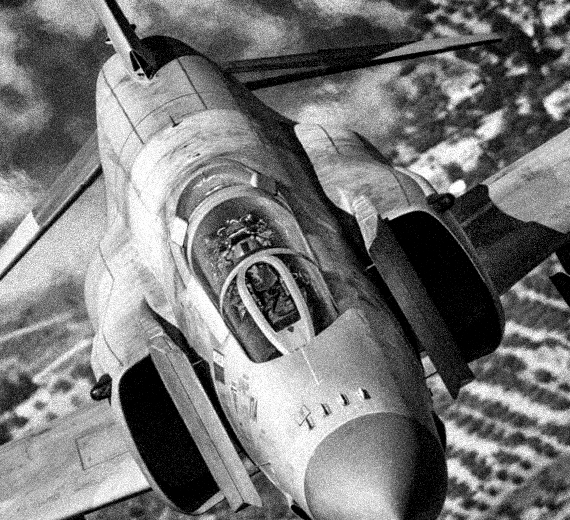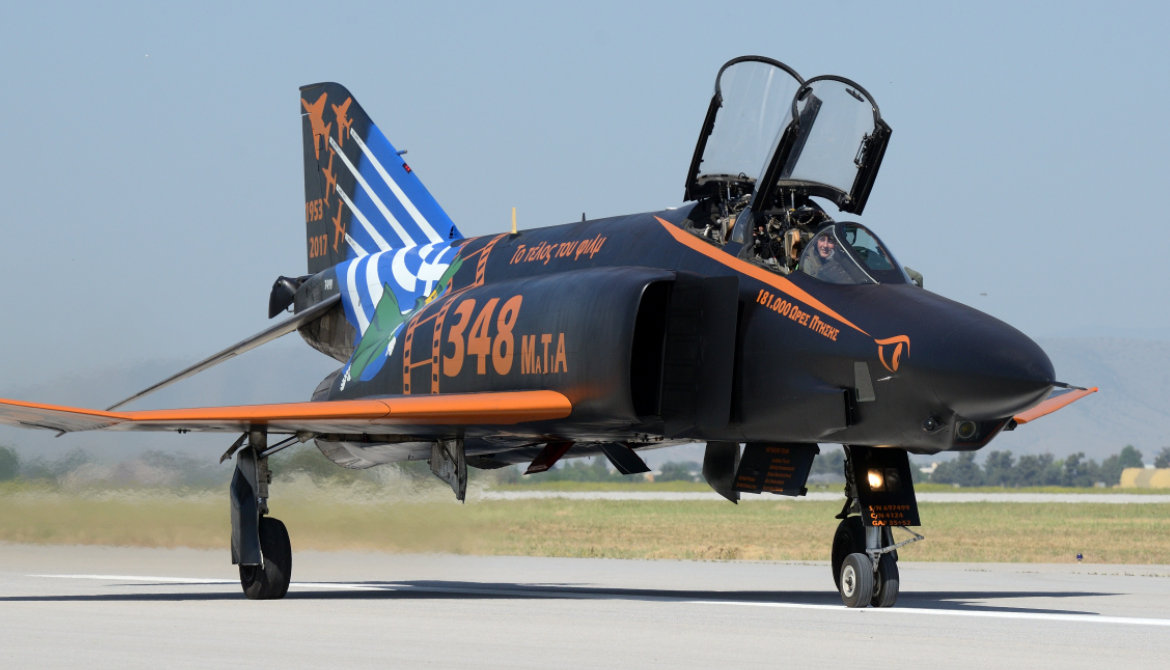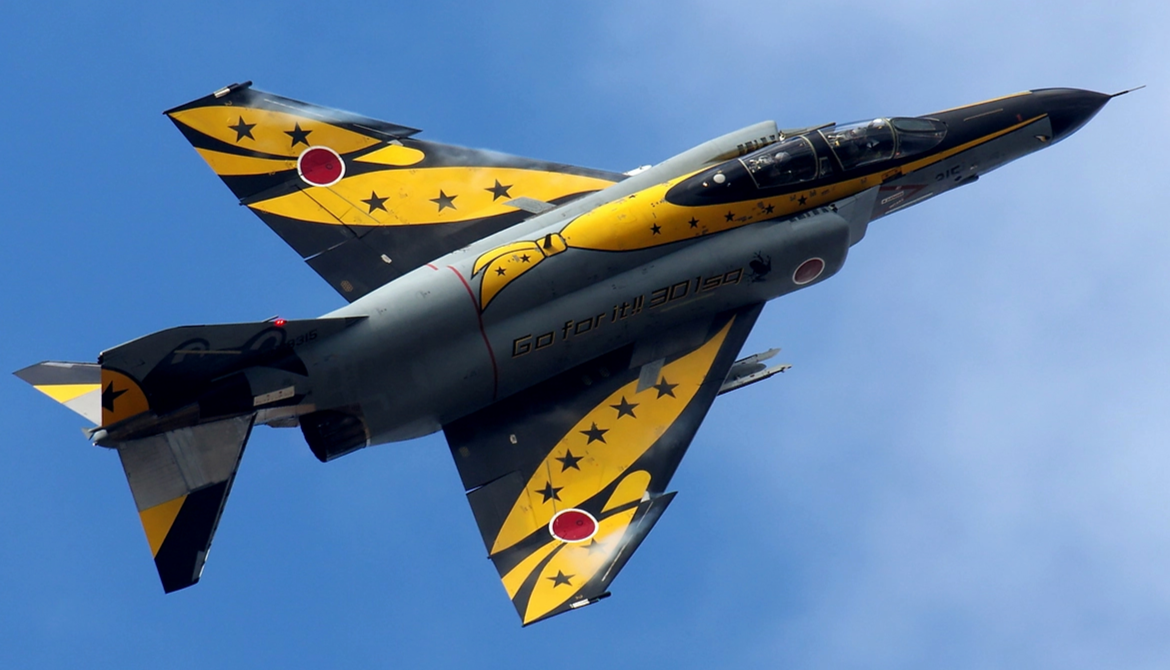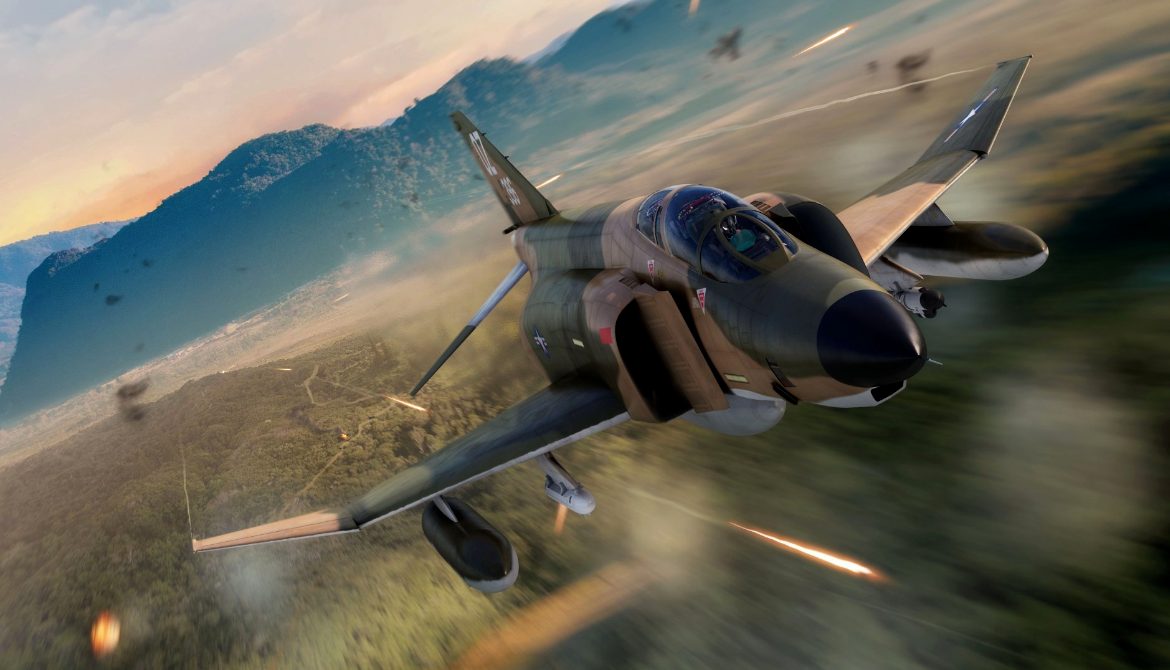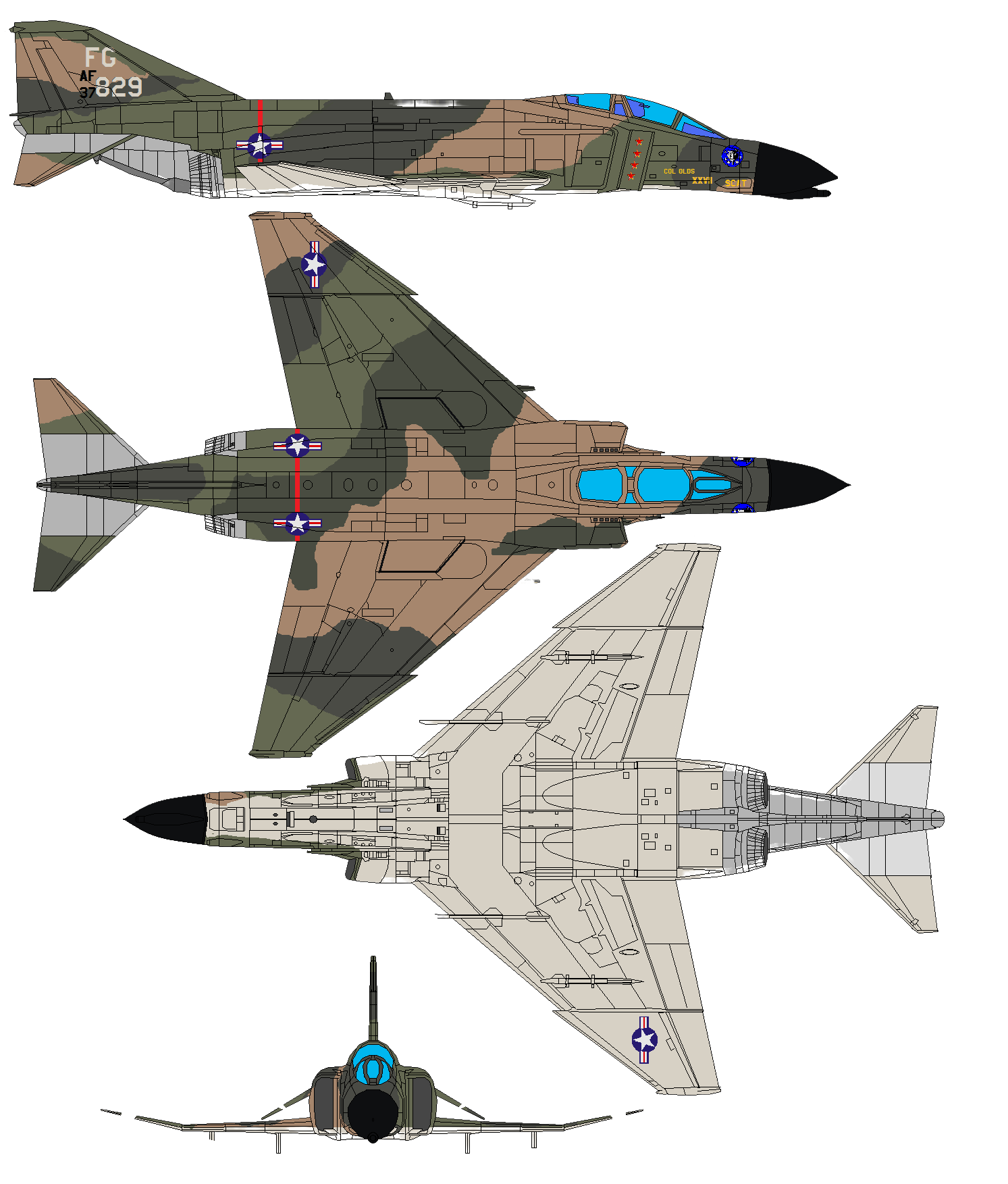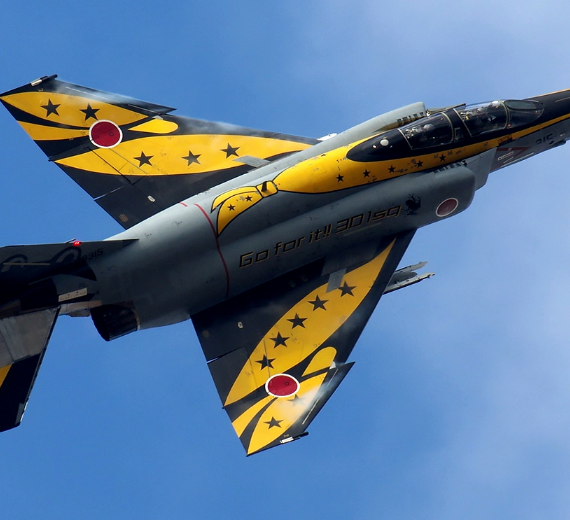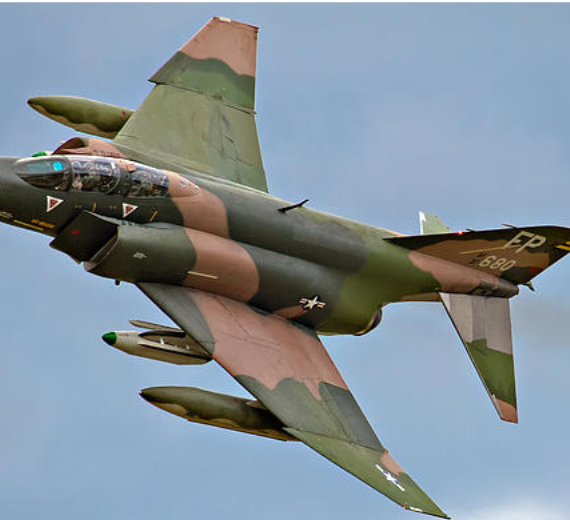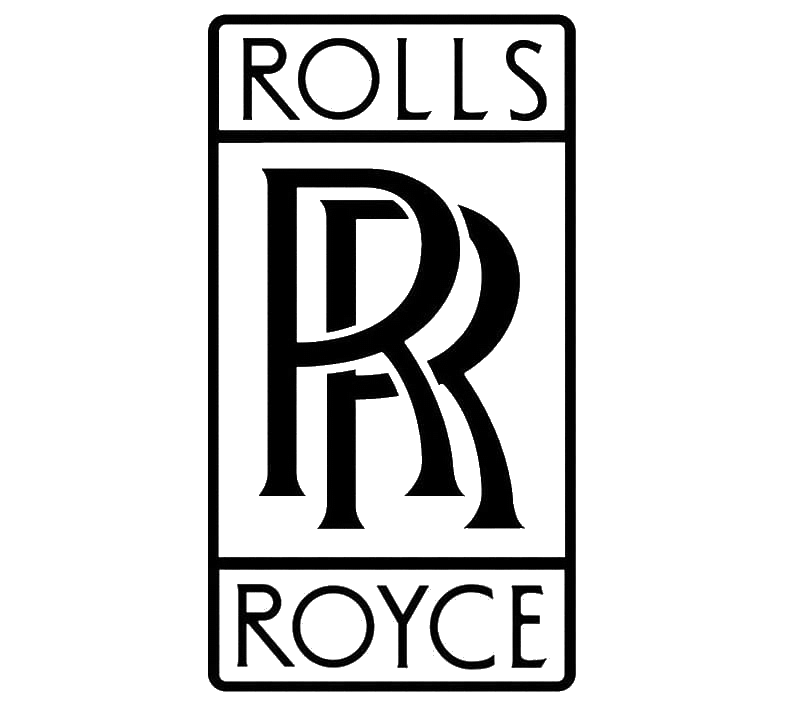McDonnell/Douglas
F-4 Phantom II
Role Interceptor, fighter-bomber
National origin United States
Manufacturer McDonnell Aircraft Corporation
McDonnell Douglas
First flight 27 May 1958
Introduction 1961
Retired 1996 (U.S. combat use)
2013 (Germany)
2016
(U.S. target drone) 2021 (Japan)
Status In limited service
Primary users United States Air Force (historical)
United States Navy (historical)
United States Marine Corps
Produced 1958–1981
Number built 5,195
Variants McDonnell Douglas Phantom FG.1/FGR.2
.
History McDonnell/Douglas
F-4E Phantom II "Flying Brick"

The McDonnell Douglas F-4 Phantom II is an American tandem two-seat, twin-engine, all-weather, long-range supersonic jet interceptor and fighter-bomber originally developed by McDonnell Aircraft for the United States Navy. Proving highly adaptable, it entered service with the Navy in 1961[3] before it was adopted by the United States Marine Corps and the United States Air Force, and by the mid-1960s it had become a major part of their air arms
In 1953, McDonnell Aircraft began work on revising its F3H Demon naval fighter, seeking expanded capabilities and better performance. The company developed several projects, including a variant powered by a Wright J67 engine,[16] and variants powered by two Wright J65 engines, or two General Electric J79 engines. The J79-powered version promised a top speed of Mach 1.97. On 19 September 1953, McDonnell approached the United States Navy with a proposal for the "Super Demon". Uniquely, the aircraft was to be modular, as it could be fitted with one- or two-seat noses for different missions, with different nose cones to accommodate radar, photo cameras, four 20 mm (.79 in) cannon, or 56 FFAR unguided rockets in addition to the nine hardpoints under the wings and the fuselage. The Navy was sufficiently interested to order a full-scale mock-up of the F3H-G/H, but felt that the upcoming Grumman XF9F-9 and Vought XF8U-1 already satisfied the need for a supersonic fighter.
The McDonnell design was therefore reworked into an all-weather fighter-bomber with 11 external hardpoints for weapons and on 18 October 1954, the company received a letter of intent for two YAH-1 prototypes. Then on 26 May 1955, four Navy officers arrived at the McDonnell offices and, within an hour, presented the company with an entirely new set of requirements. Because the Navy already had the Douglas A-4 Skyhawk for ground attack and F-8 Crusader for dogfighting, the project now had to fulfill the need for an all-weather fleet defense interceptor. A second crewman was added to operate the powerful radar; designers believed that air combat in the next war would overload solo pilots with information.
0
KmCeiling
0
KmCombat RANGE
0
Km/hAircraft Speed
0
Max Crew
Photo Gallery
McDonnell/Douglas
F-4E Phantom II "Flying Brick"


McDonnell/Douglas
F-4E Phantom II "Flying Brick"
General Info
-
-
- Crew: 2
- Length: 63 ft 0 in (19.2 m)
- Wingspan: 38 ft 5 in (11.7 m)
- Width: 27 ft 7 in (8.4 m) wing folded
- Height: 16 ft 5 in (5 m)
- Wing area: 530 sq ft (49.2 m2)
- Aspect ratio: 2.77
-
Powerplant
-
- Empty weight: 30,328 lb (13,757 kg)
- Gross weight: 41,500 lb (18,824 kg)
- Max takeoff weight: 61,795 lb (28,030 kg)
- Maximum landing weight: 36,831 lb (16,706 kg)
- Fuel capacity: 1,994 US gal (1,660 imp gal; 7,550 L) internal, 3,335 US gal (2,777 imp gal; 12,620 L) with 2x 370 US gal (310 imp gal; 1,400 L) external tanks on the outer wing hardpoints and either a 600 or 610 US gal (500 or 510 imp gal; 2,300 or 2,300 L) tank for the center-line station.
- Powerplant: 2 × General Electric J79-GE-17A after-burning turbojet engines
-
Performance
- Maximum speed: 1,280 kn (1,470 mph, 2,370 km/h) at 40,000 ft (12,000 m)
- Maximum speed: Mach 2.23
- Cruise speed: (580 mph, 940 km/h)
- Combat range: (420 mi, 680 km)
- Ferry range: (1,677 mi, 2,699 km)
- Service ceiling: 60,000 ft (18,000 m)
Armament
- E-model has a 20 mm (0.787 in) M61A1 Vulcan cannon mounted internally under the nose, 640 rounds
- Up to 18,650 lb (8,480 kg) of weapons on nine external hardpoints, including general-purpose bombs, cluster bombs, TV- and laser-guided bombs, rocket pods, air-to-ground missiles, anti-ship missiles, gun pods, and nuclear weapons. Reconnaissance, targeting, electronic countermeasures and baggage pods, and external fuel tanks may also be carried.
- 4× AIM-9 Sidewinders on wing pylons, Israeli F-4 Kurnass 2000 carried Python-3, Japanese F-4EJ Kai carry AAM-3.
- 4× AIM-7 Sparrow in fuselage recesses, upgraded Hellenic F-4E and German F-4F ICE carry AIM-120 AMRAAM, UK Phantoms carried Skyflash missiles
.
Links to Youtube & Others
The Phantom gathered a number of nicknames during its career. Some of these names included "Snoopy", "Rhino", "Double Ugly", "Old Smokey",[65] the "Flying Anvil", "Flying Footlocker", "Flying Brick", "Lead Sled", the "Big Iron Sled", and the "St. Louis Slugger"
McDonnell/Douglas
F-4E Phantom II
The F-4 was used extensively during the Vietnam War. It served as the principal air superiority fighter for the U.S. Air Force,.
Youtube Link
The F-4 Phantom II remained in use by the U.S. in the reconnaissance and Wild Weasel (Suppression of Enemy Air Defenses) roles in the 1991 Gulf War.

